Functions and Graphs
Express the area and circumference of a circle as functions of the circle’s radius. Then express the area as a function of the circumference.
 Verified step by step guidance
Verified step by step guidance Verified video answer for a similar problem:
Verified video answer for a similar problem:



 1:36m
1:36mMaster Introduction to Calculus Channel with a bite sized video explanation from Patrick
Start learning